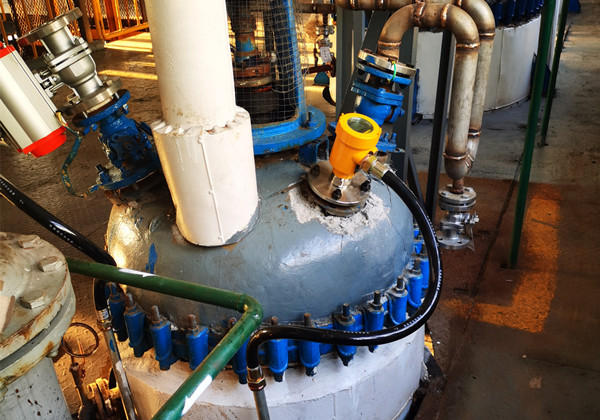A company used our radar level meter to measure sulphuric acid and hydrochloric acid at ambient temperature and pressure, using two types of radar level meters, model RD-906, and RD-FMW11 respectively. The customer contacted us for help. Our after-sales engineer arrived at the site and adjusted the range of the radar level meter to a suitable value according to the site conditions, and adjusted the angle of the reflector plate of the RD-FMW11 radar level meter according to the requirements to make it receive the transmitting signal better. After commissioning, the radar level meter started to measure accurately and steadily.

The radar-level antenna emits narrow microwave pulses, which are transmitted downwards by the antenna. The microwaves contact the surface of the measured medium and are reflected back to be received again by the antenna system, which transmits the signal to the electronic circuit part to be automatically converted into a level signal (because of the extremely fast propagation of microwaves, the time taken for the electromagnetic waves to reach the target and return to the receiver by reflection is almost instantaneous).
Two of our radar level meters are used in this case, a high-frequency radar level meter and an FM radar level meter, both of which have their own advantages. The FM radar level meter uses millimeter wave radar, with a measurement accuracy of up to ±2mm and a minimum blind spot of 0.1m.

With a variety of lens antennas, the emission angle is small, the energy is very concentrated and the echo signal is strong, which is more reliable than other radar products under the same mining conditions. Strong penetration, even in the presence of adhesion and condensation.
The dynamic signal range is greater and the measurement is more stable for low dielectric constant media. A wide range of measurement modes, with a radar response time of less than 1S in fast measurement mode, and a high-frequency radar level meter range with a small antenna size for easy installation.
The short wavelength for better reflection on inclined solid surfaces. Smaller measurement blind spot, which gives good results even for small tanks. The high signal-to-noise ratio for better performance even in fluctuating conditions.
Excellent wave speed aggregation, which, together with the many types of antennae, enables good measurements in a wide range of situations. They can all be used to measure acidic liquids, and the choice is still dependent on the actual situation.

After the installation of the radar level meter is complete, it is necessary to debug, only accurate and detailed debugging, so that the parameters of the radar level meter and the site working conditions match, in order to make the radar level meter work better, which is a very important part of the work.
